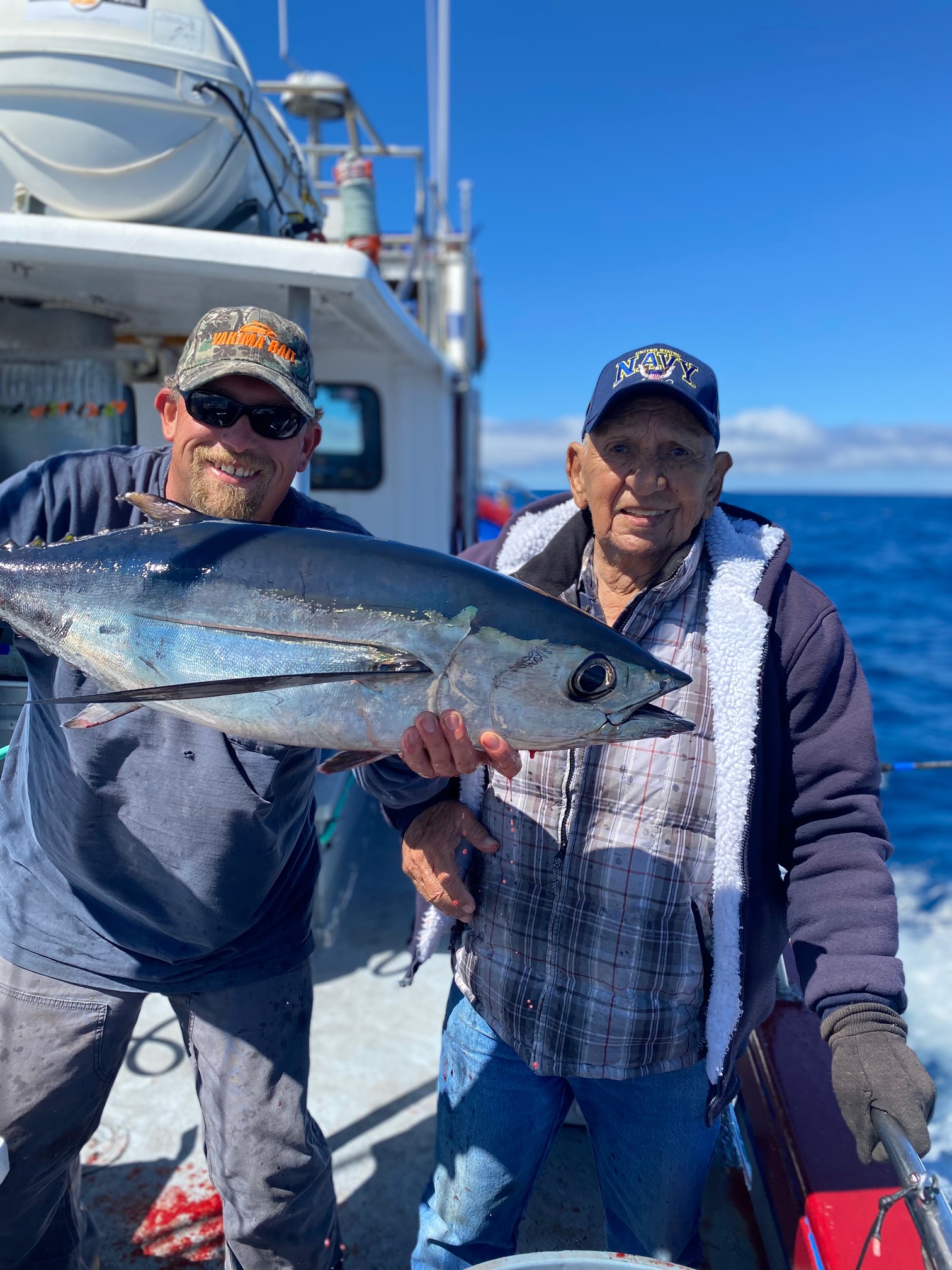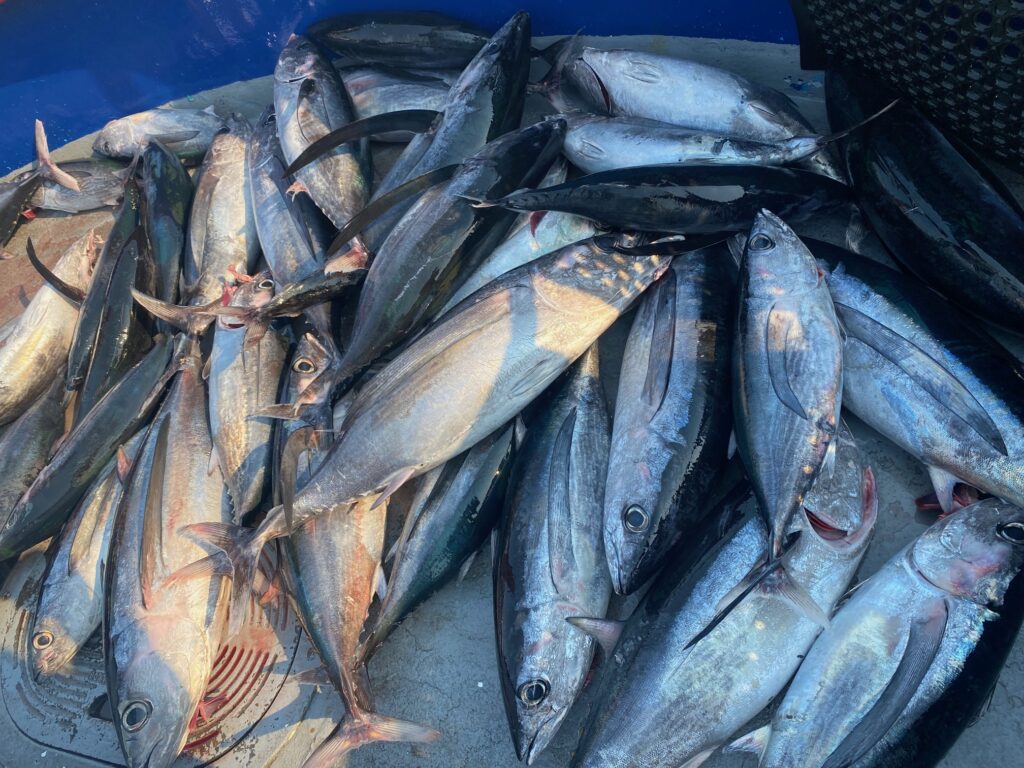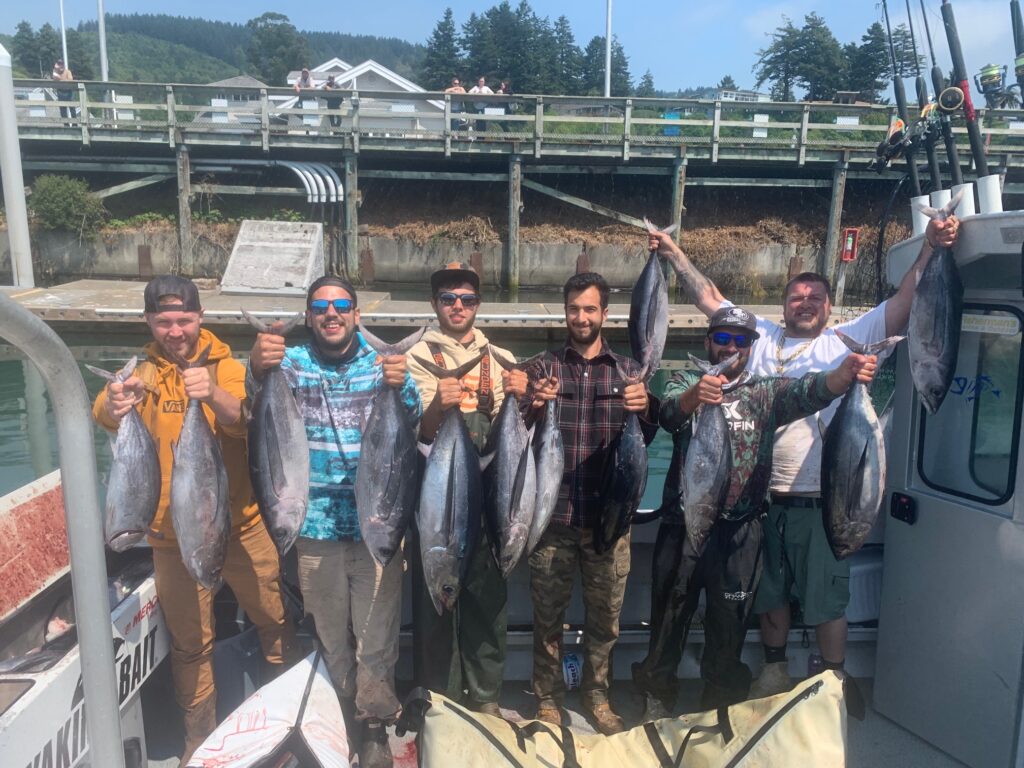Fishing Reports

Tuna Time: Raw power, thrilling takedowns makes albacore tuna fishing addictive
The following story appeared in the Roseburg News-Review in August 2023, after the Brookings Fishing Charters fleet ran its first tuna trips of the season. The author fished aboard the Nauti-Lady, while the Miss Brooke, Kraken, Dash and Papa B also ventured 50 miles offshore, each returning with five to six dozen albacore on each boat.

(By CRAIG REED) BROOKINGS, Ore. – Schools of Pacific albacore tuna have arrived in the waters off the Oregon Coast. Anglers on chartered and private boats are in pursuit of the fish that is known for its wonderful flavor. The chase started in July and usually runs into September.
Fishing for tuna is legal year-round, but their presence in warm water currents within a reasonable distance of Oregon’s shoreline limits recreational fishing to about three months. Ocean conditions are also a key factor in getting out to the fish.

The best fishing, and hopefully catching, is in clear, dark blue water with a temperature of 60 degrees or higher. When those warm waters and the schools of tuna that inhabit them are 15 to 50 miles offshore, boats from the Oregon ports of Bandon, Brookings, Charleston, Coos Bay, Newport and Winchester Bay head out. Depending on the boat size, its power and the distance offshore, anglers should be prepared for a two- to four-hour boat ride to the hot spots before dropping lines and jigs.


The charter companies run 12-hour trips, but anglers should be aware half of that time or more could be spent traveling out to warm water and then finding a school of fish.
Andy Martin, owner of Brookings Fishing Charters (www.brookingsfishing.com) in Brookings, and Wayne Butler, owner of Prowler Charters in Bandon, gave similar descriptions of the tuna fishing experience — it’s like trying to reel in a car going the other direction.
“When you hook up and you’ve got one fish thrashing around, the other fish go into frenzy and then you’ve got multiple hookups,” Martin said. “They have raw power and then sudden bursts of speed. There’s never a harder strike than when you’re holding the rod. Periods of chaos with multiple hookups is what makes tuna fishing so exciting.”
“It’s an absolute ball when you get into the tuna good,” Butler said. “It’s a frenzy. Getting several fish on at a time is absolute crazy fun.”

Boats troll at about 8 mph with lines and jigs at different distances off the boat so lines don’t get tangled. When a line goes “zing, zing, zing,” a tuna is on. Then several seconds of patience is needed because the jigs are passing through a school of tuna and if one fish hits, by continuing to troll, others are likely to hit the other jigs.
The boat is then put in neutral, anglers grab the rods and start cranking on the reels. When hooked, the tuna go down. When reeling, the fish don’t rise to the surface and jump out of the water or zip left and right. It’s usually just a hard pull up until the fish are near the boat and then they might zip one way or the other.

The torpedo-shaped Pacific albacore tuna generally range in weight from 10 to 35 pounds.
Barb Hunt of White City and Deb Richardson of Las Vegas both recently experienced their first tuna fishing trips on the Nauti-Lady, Brookings Fishing Charters’ 42-foot boat. They each caught their first tuna and several more on the 12-hour trip that took them 45 miles out to sea.
“It was amazing, it was more than I anticipated,” Hunt said. “I didn’t know much about tuna fishing, but it was exciting to have so many fish on at a time. They fight, they pull line, yes, they’re hard to reel in.”
Hunt and Richardson each caught their first tuna on the boat’s first hookup. Of the seven lines out, five went down in a matter of seconds and then five of the seven anglers on board grabbed a rod and started reeling.
“I thought it was fantastic,” Richardson said. “I’ll definitely go back.”


Rachel Craven, co-owner of Yaquina Bay Charters in Newport, said her company’s two large boats have been catching tuna averaging 16 pounds a fish on their trips over the last three weeks.
“Realistically on our tuna trips, we would expect anywhere from three to eight fish per person,” Craven said. “It’s an extremely popular fishery and tuna is a fish people enjoy eating.”
“They have raw power and then sudden bursts of speed. There’s never a harder strike than when you’re holding the rod. Periods of chaos with multiple hookups is what makes tuna fishing so exciting.”
Mike Van Camp of Merlin has made several tuna fishing trips. His advice is to plan on a 30-mile trip out when told the tuna are 20 miles out.
“That water moves and changes with wind currents and tides,” he said. “There’s a lot of water out there and 90% of what you see is just water. The other 5 to 10% holds the fish so it might take a while to find the tuna.”
“It’s addictive,” he added of tuna fishing. “The action when you find them is absolutely non-stop.”
Tuna are warm blooded so it’s important after getting a fish on board to quickly bleed it and get it on ice to get its body temperature down.


Keeping the fish on ice for the duration of the trip maintains its quality.
An additional thrill for the tuna anglers is to see pods of dolphins or porpoises and possibly humpback whales on the long trips. The dolphins and porpoises love to race alongside boats for short distances.
Depending on the charter company, the size of the boat and the number of anglers per boat, the 12-hour tuna fishing trips range in price from $300 to $500. Charters have smaller boats that can take four to six anglers or larger boats that aren’t as fast in getting to fishing spots, but can take up to 12 anglers and provide them with more space and comfort and a little smoother ride over the ocean’s swells.
“The tuna fishing has been good and it’s shaping up to be very good,” Butler said of this year’s tuna season.
The Brookings Fishing Charters fleet runs tuna trips as early as late June, but most often in July and August. The best way to get on a tuna trip is to call the office, (541) 813-1082, to get on the call list. Tuna trips are put together when weather conditions flatten out and there are reports of tuna in reasonably close to shore. Ideally, tuna are 20 to 30 miles offshore, but charters will run up to 50 miles offshore. The closer the tuna, the more time spent fishing for them instead of running further out.

For more on tuna fishing on the Oregon Coast, visit this page. During tuna trips, charter boats out of Brookings will often venture north to Gold Beach or south to Crescent City, finding the perfect water with the best action. Brookings is centrally located near some of the best albacore tuna water off the West Coast in early to mid-summer.
Here are some more tuna photos from the first trips of the season in 2023 aboard the Nauti-Lady, Miss Brooke, Kraken, Papa B and Dash.
















